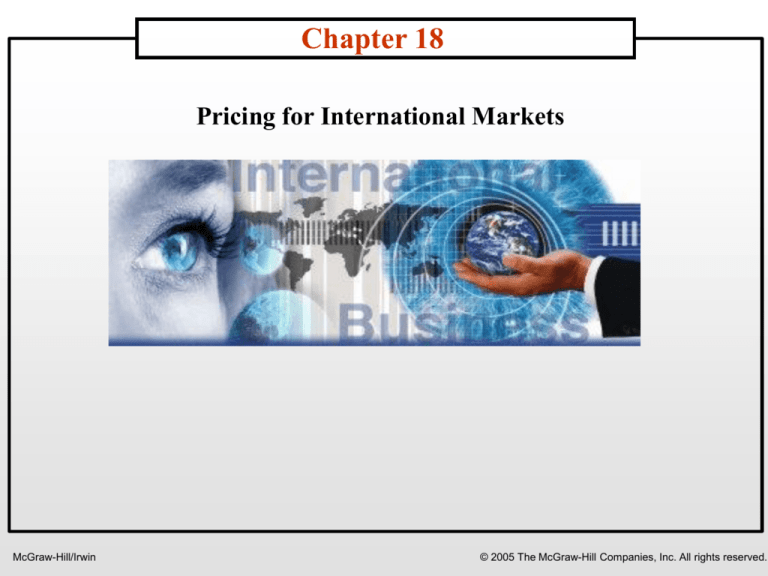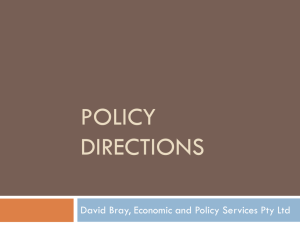
Chapter 18
Pricing for International Markets
McGraw-Hill/Irwin
© 2005 The McGraw-Hill Companies, Inc. All rights reserved.
Chapter Learning Objectives
1. Components of pricing as competitive tools in
international marketing
2. The pricing pitfalls directly related to
international marketing
3. How to control pricing in parallel imports or
gray markets
Chapter Learning Objectives
4. Price escalation and how to minimize its
effect
5. Countertrading and its place in international
marketing practice
6. The mechanics of price quotations
Pricing Policy
A.
2 Pricing Objectives:
– 1. As an active means of attaining marketing
objectives
Companies
use this when trying to achieve certain
objectives, profit margins or targeted market share.
– 2. As a static element in a business decision
Companies use this when they are foreign
marketing is not a priority
– Usually associated with trying to get rid of
excess inventories
•
The more control a company has over the final selling price of a product, the
better it is able to achieve its marketing goals
•
It is not always possible to control end prices
Pricing Policy
B. Parallel Imports
– Where a manufacturing company sells its products to
a specific country; and those products are further sold
to another unintended country
“Gray Market” situation can occur
See Crossing Borders 18-1 pg. 532 (Levi Strauss)
C. Exclusive Distribution
– Where manufacturers select preferred distributors to
sell its products at premium prices in order to:
Maintain high profit margins; stock large
assortments; and to maintain the exclusive quality
image.
This also contributes to parallel imports
Exhibit 18.1 pg. 534 “How Gray-Market Goods End
Up in the U.S.”
Pricing Policy
Approaches to International Pricing
– Full Cost vs Variable Cost
Full
Cost is determined by combining the total cost
plus a profit margin to every unit
– Every unit must bear the total cost (including
international units sold)
Variable cost is determined thru the incremental
cost associated with producing goods for selling
them in international markets
– Can appear to be “dumping”
Pricing Policy
Approaches to International Pricing
– Skimming Vs. Penetration Pricing
Skimming is used when the marketplace is
insensitive to price; therefore premium price is
charged
– Market places high value on items either
because of it’s unique features; quality or it has
little or no competition
Penetration Pricing is used to stimulate market
growth; therefore prices are set low
– See “Crossing Borders” 18.2 pg. 550 (Charmin
– using skimming of penetration pricing policies
in Britain?)
Price Escalation
•
Price escalation refers to the added costs incurred as a result of
exporting products from one country to another
There are several factors that lead to higher prices:
1.
Costs of Exporting: the term relates to
situations in which ultimate prices are
raised by shipping costs, insurance,
packing, tariffs, longer channels of
distribution, larger middlemen margins,
special taxes, administrative costs, and
exchange rate fluctuations
Price Escalation (Cont.)
2.
3.
Taxes, Tariffs, and Administrative
Costs: These costs results in higher
prices, which are generally passed on to
the buyer of the product
Inflation: Inflation causes consumer prices
to escalate and the consumer is faced with
rising prices that eventually exclude many
consumers from the market
Price Escalation (Cont.)
4.
Middleman and Transportation
Costs: Longer channel length,
performance of marketing functions
and higher margins may make it
necessary to increase prices
5.
Exchange Rate Fluctuations and
Varying Currency Values: Currency
values swing vis-à-vis other currencies
on a daily basis, which may make it
necessary to increase prices
Effects of Price Escalation and Sample Causes
Domestic
Example
18-6
Manufacturing net
Transport, c.i.f.
Tariff (20 percent c.i.f. value)
Importer pays
Importer margin when
sold to wholesaler
(25 percent) on cost
Wholesaler pays landed cost
Foreign
Example 1:
Assuming the
same channels with
wholesaler importing directly
Foreign
Example 2:
Importer and
same margins
and channels
$ 5.00
n.a.
n.a.
n.a.
$ 5.00
6.10
1.22
n.a.
$ 5.00
6.10
1.22
7.32
n.a.
5.00
n.a.
7.32
1.83
9.15
1.67
6.67
2.44
9.76
3.05
12.20
Retail margin (50 percent on cost) 3.34
Retail price
10.01
4.88
14.64
6.10
18.30
Wholesaler margin
(331/3 percent on cost)
Retailer pays
Foreign
Example 3:
Same as 2 but
with 10 percent
cumulative
turnover tax
$ 5.00
6.10
1.22
7.32
1.83
+0.73 *
2.56
+9.88
3.29
+0.99 *
=4.28
14.16
7.08
+1.42 *
=8.50
22.66
Notes: a. All figures in U.S. dollars; c.i.f = cost, insurance, and freight; n.a. = not applicable.
b. The exhibit assumes that all domestic transportation costs are absorbed by the middleman.
c. Transportation, tariffs, and middleman margins vary from country to country, but for purposes of
comparison, only a few of the possible variations are shown.
* Turnover Tax
Irwin/McGraw-Hill
Price Escalation
The Lower Prices are at Home
New York
Paris
Tokyo
1.23
$ 7.07
$ 6.53
7.50
10.50
7.89
17.29
4.55
Levi 501 jeans
39.99
74.92
75.40
79.73
54.54
Ray-Ban sunglasses
45.00
88.50
81.23
134.49
89.39
Sony Walkman
59.95
74.98
86.00
211.34
110.00
Nike Air Jordans
125.00
134.99
157.71
172.91
154.24
Nikon camera
629.95
840.00
691.00
768.49
1,054.42
Madrid Stockholm Berlin
Rome
Aspirin
Movie
18-7
$
0.99
Los Angeles
Mariah Carey CD
Windows 98
Diapers
Irwin/McGraw-Hill
London
$
Mexico City
$
1.78
16.22
16.09
17.82
15.31
20.67
117.99
123.94
179.79
211.20
264.46
13.52
5.03
5.42
6.86
10.55
SOURCE: Norihiki Shirouzu, “Luxury Prices for U.S. Goods No Longer Pass
Muster in Japan,” Wall Street Journal, February 8, 1996, p. B1; and Elizabeth
Fleick, “The Cost of Europe: Buyer Beware, Europeans Are Getting Mad as Hell
about Prices,” Time International, December 13, 1999, p. 38.
Price Escalation
How
to Lower the Effects of Price Escalation
– 1. Lower cost of goods through
Manufacturing overseas where labor costs are lower (China)
Eliminate features or product quality
– Proctor Gamble’s strategy for selling toilet paper in Brazil
– 2. Lower tariffs through
Reclassification
Persuading foreign country’s government
Modification of product to fit in another class
– 3. Lower distribution costs through
Eliminate or reduction of middlemen
– Especially where value-added taxes are imposed
Price Escalation
How
to Lower the Effects of Price Escalation
– 4. Using Foreign Trade Zones
Imported
goods stored or processed without
imposing tariffs or duties until items leave FTZ
areas and is imported into host country
FTZ’s can lower costs through:
– Lower duties imposed
– Lower labor costs in importing country
– Lower ocean transportation costs with
unassembled goods (weight and volume are
less)
– Using local materials in final assembly
See Exhibit 18.4 “How Are Foreign Trade Zones
Used?”
Pricing Issues
Issues with different methods of pricing strategies:
– 1. Dumping
Defined as either products that are sold in international
markets below their production cost; or products priced lower
in foreign markets than sold in the company’s domestic
markets
WTO has set up penalties for dumping thru:
– Countervailing duties
– Minimum Access Volume (MAV)(restricts volume that can
a country can import)
– 2. “Screwdriver Plants”
Company sets up plants to assemble products in the importing
country where they sell the final products.
Countertrade as a Pricing Tool
•
Countertrade is a pricing tool that every international marketer
must be ready to employ
•
There are four distinct transactions in countertrading, which
include:
1.
2.
3.
4.
Barter: is the direct exchange of goods between two parties in a transaction
Compensation deals: is the payment in goods and in cash
Counter-purchase or off-set trade: the seller agrees to sell a product at a
set price to a buyer and receives payment in cash and may also buy goods
from the buyer for the total monetary amount involved in the first contract or
for a set percentage of that amount, which will be marketed by the seller in
its home market
Buy-back: This type of agreement is made the seller agrees to accept as
partial payment a certain portion of the output that are produced from the
plant or machinery that are sold to the buyer
Other Pricing Strategies
3.
Transfer Pricing Strategy
– Intra-company transfer of pricing
4.
Administered Pricing
– Attempt by companies within same industry to set
prices in international markets
Cartels
– OPEC
– Shipping Industry
– Diamond cartel – controlled by DeBeers
– 5. Government Influenced Pricing
Transfer Pricing Strategy
•
Prices of goods transferred from a company’s operations or
sales units in one country to its units elsewhere, which refers to
intracompany pricing or transfer pricing, may be adjusted to
enhance the ultimate profit of the company as a whole
Four arrangements for pricing goods for intracompany transfer are as follows:
1.
2.
3.
4.
Sales at the local manufacturing cost plus a
standard markup
Sales at the cost of the most efficient producer
in the company plus a standard markup
Sales at negotiated prices
Arm’s-length sales using the same prices as
quoted to independent customers
Benefits of Transfer Pricing Strategy
1. Lowering duty costs by shipping goods
into high-tariff countries at minimal
transfer prices so that duty base and
duty are low
2. Reducing income taxes in high-tax
countries by overpricing goods
transferred to units in such countries;
profits are eliminated and shifted to
low-tax countries
3. Facilitating dividend repatriation when
dividend repatriation is curtailed by
government policy by inflating prices
of goods transferred






